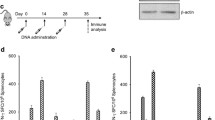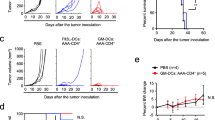Abstract
Purpose: Peritumoral CpG-oligodeoxynucleotide (ODN) treatment has been successful in tumor mouse models expressing strong antigens to induce activation of tumor-specific CD8+ T lymphocytes which contribute to the control of tumor growth. To get near to clinical reality, the tumor-specific CD8+ response was investigated in mice bearing the weakly immunogenic B16 melanoma tumor and using the melanocyte differentiation tyrosinase-related protein 2 (TRP-2) as a tracking antigen. Methods: The expansion and activation of TRP-2–specific T lymphocytes by CpG-ODNs was analyzed by tetramer staining and IFN-γ production assays, while the activity of these cells in both memory and primary response was evaluated in vivo. Results: After CpG-ODN treatment, the number of TRP-2 tetramer-stained CD8+ T lymphocytes was not significantly modified, but these cells produced higher levels of interferon γ (IFN-γ) in response to the antigen than those from untreated mice. Mice possessing these activated T lymphocytes, when evaluated for their antitumor memory response, showed marginal protection against intravenous (i.v.) and subcutaneous (s.c.) tumor rechallenge. These cells were not crucial for the control of primary tumor growth since strong reduction of subcutaneous tumor was observed after CpG-ODN treatment in both CD8+ T cell depleted or nondepleted mice. On the contrary, NK cell depletion markedly reduced CpG-ODN-induced tumor growth inhibition. Conclusions: Altogether, these data indicate the CpG treatment activates tumor-reactive effector CD8+ T lymphocytes, but, paralleling recent clinical observations, our model indicates that the mere activation of antitumor T cells is insufficient to result in a clinical response.





Similar content being viewed by others
Abbreviations
- CpG:
-
unmethylated CpG dinucleotides
- ODNs:
-
oligodeoxynucleotides
- TLR9:
-
toll-like receptor 9
- TRP-2:
-
tyrosinase-related protein 2
References
Anichini A, Molla A, Mortarini R, Tragni G, Bersani I, Di Nicola M, Gianni AM, Pilotti S, Dunbar R, Cerundolo V, Parmiani G (1999) An expanded peripheral T cell population to a cytotoxic T lymphocyte (CTL)-defined, melanocyte-specific antigen in metastatic melanoma patients impacts on generation of peptide-specific CTLs but does not overcome tumor escape from immune surveillance in metastatic lesions. J Exp Med 190:651
Auf G, Carpentier AF, Chen L, Le Clanche C, Delattre JY (2001) Implication of macrophages in tumor rejection induced by CpG-oligodeoxynucleotides without antigen. Clin Cancer Res 7:3540
Ballas ZK, Krieg AM, Warren T, Rasmussen W, Davis HL, Waldschmidt M, Weiner GJ (2001) Divergent therapeutic and immunologic effects of oligodeoxynucleotides with distinct CpG motifs. J Immunol 167:4878
Bloom MB, Perry-Lalley D, Robbins PF, Li Y, El-Gamil M, Rosenberg SA, Yang JC (1997) Identification of tyrosinase-related protein 2 as a tumor rejection antigen for the B16 melanoma. J Exp Med 185:453
Bronte V, Cingarlini S, Apolloni E, Serafini P, Marigo I, De Santo C, Macino B, Marin O, Zanovello P (2003) Effective genetic vaccination with a widely shared endogenous retroviral tumor antigen requires CD40 stimulation during tumor rejection phase. J Immunol 171:6396
Carpentier AF, Chen L, Maltonti F, Delattre JY (1999) Oligodeoxynucleotides containing CpG motifs can induce rejection of a neuroblastoma in mice. Cancer Res 59:5429
Garboczi DN, Hung DT, Wiley DC (1992) HLA-A2-peptide complexes: refolding and crystallization of molecules expressed in Escherichia coli and complexed with single antigenic peptides. Proc Natl Acad Sci U S A 89:3429
Heckelsmiller K, Rall K, Beck S, Schlamp A, Seiderer J, Jahrsdorfer B, Krug A, Rothenfusser S, Endres S, Hartmann G (2002) Peritumoral CpG DNA elicits a coordinated response of CD8 T cells and innate effectors to cure established tumors in a murine colon carcinoma model. J Immunol 169:3892
Hemmi H, Takeuchi O, Kawai T, Kaisho T, Sato S, Sanjo H, Matsumoto M, Hoshino K, Wagner H, Takeda K, Akira S (2000) A Toll-like receptor recognizes bacterial DNA. Nature 408:740
Hornung V, Rothenfusser S, Britsch S, Krug A, Jahrsdorfer B, Giese T, Endres S, Hartmann G (2002) Quantitative expression of toll-like receptor 1–10 mRNA in cellular subsets of human peripheral blood mononuclear cells and sensitivity to CpG oligodeoxynucleotides. J Immunol 168:4531
Jackson IJ, Chambers DM, Tsukamoto K, Copeland NG, Gilbert DJ, Jenkins NA, Hearing V (1992) A second tyrosinase-related protein, TRP-2, maps to and is mutated at the mouse slaty locus. EMBO J 11:527
Kawarada Y, Ganss R, Garbi N, Sacher T, Arnold B, Hammerling GJ (2001) NK- and CD8(+) T cell-mediated eradication of established tumors by peritumoral injection of CPG-containing oligodeoxynucleotides. J Immunol 167:5247
Kranzer K, Bauer M, Lipford GB, Heeg K, Wagner H, Lang R (2000) CpG-oligodeoxynucleotides enhance T-cell receptor-triggered interferon-gamma production and up-regulation of CD69 via induction of antigen-presenting cell-derived interferon type I and interleukin-12. Immunology 99:170
Krieg AM (2002) CpG motifs in bacterial DNA and their immune effects. Annu Rev Immunol 20:709
Krieg AM, Yi AK, Matson S, Waldschmidt TJ, Bishop GA, Teasdale R, Koretzky GA, Klinman DM (1995) CpG motifs in bacterial DNA trigger direct B-cell activation. Nature 374:546
Lee KH, Wang E, Nielsen MB, Wunderlich J, Migueles S, Connors M, Steinberg SM, Rosenberg SA, Marincola FM (1999) Increased vaccine-specific T cell frequency after peptide-based vaccination correlates with increased susceptibility to in vitro stimulation but does not lead to tumor regression. J Immunol 163:6292
Lipford GB, Sparwasser T, Bauer M, Zimmermann S, Koch ES, Heeg K, Wagner H (1997) Immunostimulatory DNA: sequence-dependent production of potentially harmful or useful cytokines. Eur J Immunol 27:3420
Lipford GB, Bendigs S, Heeg K, Wagner H (2000) Poly-guanosine motifs costimulate antigen-reactive CD8 T cells while bacterial CpG-DNA affect T-cell activation via antigen-presenting cell-derived cytokines. Immunology 101:46
Loftus DJ, Castelli C, Clay TM, Squarcina P, Marincola FM, Nishimura MI, Parmiani G, Appella E, Rivoltini L (1996) Identification of epitope mimics recognized by CTL reactive to the melanoma/melanocyte-derived peptide MART-1(27–35). J Exp Med 184:647
Lollini P, De Giovanni D, Nicoletti G, Bontadini A, Tazzari P, Landuzzi L, Scotlandi K, Nanni P (1990) Enhancement of experimental metastatic ability by tumor necrosis factor-alpha alone or in combination with interferon-gamma. Clin Exp Met 8:215
Mandruzzato S, Rossi E, Bernardi F, Tosello V, Macino B, Basso G, Chiarion-Sileni V, Rossi CR, Montesco C, Zanovello P (2002) Large and dissimilar repertoire of melan-A/MART-1-specific CTL in metastatic lesions and blood of a melanoma patient. J Immunol 169:4017
Martin-Orozco E, Kobayashi H, Van Uden J, Nguyen MD, Kornbluth RS, Raz E (1999) Enhancement of antigen-presenting cell surface molecules involved in cognate interactions by immunostimulatory DNA sequences. Int Immunol 11:1111
Rodolfo M, Castelli C, Bassi C, Accornero P, Sensi M, Parmiani G (1994) Cytotoxic T lymphocytes recognize tumor antigens of a murine colonic carcinoma by using different T-cell receptors. Int J Cancer 57:440
Rosenberg SA, Yang JC, Schwartzentruber DJ, Hwu P, Marincola FM, Topalian SL, Restifo NP, Dudley ME, Schwarz SL, Spiess PJ, Wunderlich JR, Parkurst MR, Kawakami Y, Seipp CA, Einhorn JH, White DE (1998) Immunologic and therapeutic evaluation of a synthetic peptide vaccine for the treatment of patients with metastatic melanoma. Nat Med 4:321
Sato N, Michaelides MC, Wallack MK (1983) Transplantation immunity and cross-protection of two cultured murine colon lines. J Natl Cancer Inst 70:261
Sfondrini L, Besusso D, Rumio C, Rodolfo M, Ménard S, Balsari A (2002) Prevention of spontaneous mammary adenocarcinoma in HER-2/neu transgenic mice by foreign DNA. FASEB J 16:1749
Sfondrini L, Besusso D, Zoia MT, Rodolfo M, Invernizzi AM, Taniguchi M, Nakayama T, Colombo MP, Ménard S, Balsari A (2002) Absence of CD1 molecule up-regulates antitumor activity induced by CpG oligodeoxynucleotides in mice. J Immunol 169:151
Sparwasser T, Koch ES, Vabulas RM, Heeg K, Lipford GB, Ellwart JW, Wagner H (1998) Bacterial DNA and immunostimulatory CpG oligonucleotides trigger maturation and activation of murine dendritic cells. Eur J Immunol 28:2045
Steitz J, Bruck J, Steinbrink K, Enk A, Knop J, Tuting T (2000) Genetic immunization of mice with human tyrosinase-related protein 2: implications for the immunotherapy of melanoma. Int J Cancer 86:89
Sun S, Beard C, Jaenisch R, Jones P, Sprent J (1997) Mitogenicity of DNA from different organisms for murine B cells. J Immunol 159:3119
Sun Y, Song M, Stevanovic S, Jankowiak C, Paschen A, Rammensee HG, Schadendorf D (2000) Identification of a new HLA-A(*)0201-restricted T-cell epitope from the tyrosinase-related protein 2 (TRP2) melanoma antigen. Int J Cancer 87:399
Thurner B, Haendle I, Roder C, Dieckmann D, Keikavoussi P, Jonuleit H, Bender A, Maczek C, Schreiner D, von den DP, Brocker EB, Steinman RM, Enk A, Kampgen E, Schuler G (1999) Vaccination with mage-3A1 peptide-pulsed mature, monocyte-derived dendritic cells expands specific cytotoxic T cells and induces regression of some metastases in advanced stage IV melanoma. J Exp Med 190:1669
Wagner H (1999) Bacterial CpG DNA activates immune cells to signal infectious danger. Adv Immunol 73:329
Wang RF, Appella E, Kawakami Y, Kang X, Rosenberg SA (1996) Identification of TRP-2 as a human tumor antigen recognized by cytotoxic T lymphocytes. J Exp Med 184:2207
Wang RF, Johnston SL, Southwood S, Sette A, Rosenberg SA (1998) Recognition of an antigenic peptide derived from tyrosinase-related protein-2 by CTL in the context of HLA-A31 and -A33. J Immunol 160:890
Yamamoto S, Yamamoto T, Kataoka T, Kuramoto E, Yano O, Tokunaga T (1992) Unique palindromic sequences in synthetic oligonucleotides are required to induce IFN and augment IFN-mediated natural killer activity. J Immunol 148:4072
Zeh HJ III, Perry-Lalley D, Dudley ME, Rosenberg SA, Yang JC (1999) High avidity CTLs for two self-antigens demonstrate superior in vitro and in vivo antitumor efficacy. J Immunol 162:989
Zimmermann S, Egeter O, Hausmann S, Lipford GB, Rocken M, Wagner H, Heeg K (1998) CpG oligodeoxynucleotides trigger protective and curative Th1 responses in lethal murine leishmaniasis. J Immunol 160:3627
Acknowledgements
Supported by AIRC and FIRST. L.S. was supported by a fellowship from FIRC. We thank Dr Thomas Tuting for kindly providing the hTRP-2–encoding recombinant adenovirus.
Author information
Authors and Affiliations
Corresponding author
Rights and permissions
About this article
Cite this article
Sfondrini, L., Besusso, D., Bronte, V. et al. CpG-Oligodeoxynucleotides activate tyrosinase-related protein 2–specific T lymphocytes but do not lead to a protective tumor-specific memory response. Cancer Immunol Immunother 53, 697–704 (2004). https://doi.org/10.1007/s00262-004-0516-x
Received:
Accepted:
Published:
Issue Date:
DOI: https://doi.org/10.1007/s00262-004-0516-x




